 Last additions - TOKYO 東京都 Last additions - TOKYO 東京都 |

After passing through Sangedatsu-mon Gate. Various memorials and monuments are all over the temple grounds.Feb 19, 2006
|
|

Zojoji Temple is the head temple of the Jodo-shu Buddhist sect and best known as the temple of the Tokugawa shoguns. 大門After Tokugawa Ieyasu started to rule the Kanto region, he designated Zojoji as the family temple of the Tokugawa clan. The temple was expanded during the same time Edo Castle was being built.
Zojoji then came to be known as one of Japan's principal Buddhist temples. The temple grounds have many buildings, monuments, and the tombs of six Tokugawa Shoguns, Imperial Princess Kazunomiya (wife of Shogun Iemochi), and wives and children of shoguns.
Zojoji Temple is a short walk from Onarimon Station on the Mita subway line, Daimon Station on the Toei Oedo and Asakusa subway lines, and JR Hamamatsu-cho Station. This photo shows Daimon Gate on the road to the temple.Feb 19, 2006
|
|

Sangedatsu-mon Gate with notices saying that table tennis player Fukuhara Ai and Ozeki Tochiazuma will be bean throwers for Setsubun.This is Feb. 3, 2006. 三門Feb 19, 2006
|
|
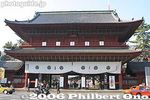
Sangedatsu-mon Gate (Sanmon) which is the temple's front gate. 三解脱門(三門)The main gate to enter the temple fronts a busy road. Important Cultural Property. "Sangedatsu" means to be released from the three earthly states of mind: greed, anger and stupidity. Walk through this gate and maybe this might happen to you.Feb 19, 2006
|
|

Feb 17, 2006
|
|

Filled with a water hoseFeb 17, 2006
|
|

Feb 17, 2006
|
|

Feb 17, 2006
|
|

Feb 17, 2006
|
|

Feb 17, 2006
|
|

Feb 17, 2006
|
|

Priests splash cold water over themselves at the Nose Myokenzan Betsuin in Sumida-ku, TokyoFeb 17, 2006
|
|

Feb 17, 2006
|
|

Feb 17, 2006
|
|

Chanting prayersFeb 17, 2006
|
|

Feb 17, 2006
|
|

Feb 17, 2006
|
|

Feb 17, 2006
|
|

Feb 17, 2006
|
|

Priests appearFeb 17, 2006
|
|

The congregation gather on the steps and beat fan-shaped drums.Feb 17, 2006
|
|

Barrels of cold waterFeb 17, 2006
|
|

Shrine hallFeb 17, 2006
|
|

Nose Myokenzan Betsuin at a street corner. In Feb., priests at this small temple splash cold water on themselves for 30 min. Near Honjo-Azumabashi Station on the Toei Asakusa Line or JR Kinshicho Station on the Sobu Line.Feb 17, 2006
|
|

Barrels of cold water in front of shrineFeb 17, 2006
|
|

Binzasara Dance from Asakusa Shrine. This dance also originated in Asakusa by farmers who celebrated the completion of a tea house in Asakusa near the Asakusa Sensoji Temple. It is now a dance to celebrate a good harvest. びんざさら舞
びんざさら舞
三社大権現祭礼 船渡御Nov 09, 2005
|
|

Oiran Dochu Procession. Passing by Matsuya Dept. Store and Tobu Asakusa Station.Nov 09, 2005
|
|
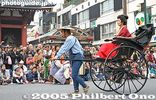
Cultural enlightenment: Higuchi Ichiyo (1872-96) was a critically-acclaimed novelist who also graces the 5,000 yen bill. At age 24, she died of tuberculosis. 文明開化 樋口一葉Nov 09, 2005
|
|

Asakusa Folk Entertainment. Behind the Asakusa Temple, there was a variety of shows, street performers, plays, and other characters. Asakusa has always been Tokyo's entertainment center. 浅草奥山風景Nov 09, 2005
|
|
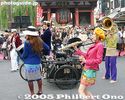
Asakusa Folk Entertainment. This was the last act. Somewhat tacky end to the festival.Nov 09, 2005
|
|

Shinsengumi disbanded when the shogunate collapsed and Emperor Meiji became the head of state. The Shinsegumi wore a distinct costume with a light blue haori. 新撰組Nov 09, 2005
|
|

Shinsengumi新撰組Nov 09, 2005
|
|
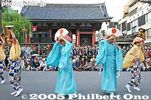
Asakusa Folk Entertainment 浅草奥山風景Nov 09, 2005
|
|

1868: Transition from Edo to Tokyo (Saigo Takamori). With the Meiji Restoration in 1868, the ruler of Japan shifts from the shogun to an oligarchy ruling under the banner of the emperor. Edo is renamed Tokyo. 江戸から東京へWith the Meiji Restoration in 1868, the ruler of Japan shifts from the shogun to an oligarchy ruling under the banner of the emperor. Edo is renamed as "Tokyo (Tokio)," meaning "Eastern Capital," as ordered by Emperor Meiji.
江戸から東京へNov 09, 2005
|
|

Townsend Harris and Commodore Perry 黒船来航・浦賀奉行Nov 09, 2005
|
|
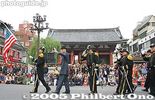
Townsend Harris and Commodore Perry, played by Americans from Yokosuka Naval Base. 黒船来航・浦賀奉行Nov 09, 2005
|
|
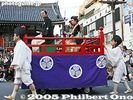
Year 1867: Tokugawa Yoshinobu, the 15th and last shogun who surrendered power to the emperor and fled Edo in 1868 following military defeat by powerful provincial lords seeking to return power to the Emperor. 第十五代将軍 徳川慶喜第十五代将軍 徳川慶喜Nov 09, 2005
|
|
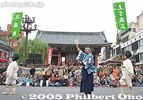
Shinsengumi was a Kyoto-based, pro-shogunate group of skilled swordsmen of Edo and masterless samurai in Kyoto formed to suppress the growing opposition (especially from Choshu) against the shogunate in favor of restoring the Emperor to power. 新撰組The group disbanded when the shogunate collapsed and Emperor Meiji became the head of state. 新撰組Nov 09, 2005
|
|

Edo Geisha江戸芸者Nov 09, 2005
|
|

This was the only one who had a smile. The others were quite serious and solemn.Nov 09, 2005
|
|

Mistress Okichi, the infamous mistress of Townsend Harris, America's first ambassador to Japan when he was in Shimoda. Another mistress was provided to Harris' interpreter.Okichi was the infamous mistress of Townsend Harris, America's first ambassador to Japan. Another mistress was provided to Harris' interpreter.
黒船来航・浦賀奉行Nov 09, 2005
|
|

Arrival of Black Ships 黒船来航・浦賀奉行黒船来航・浦賀奉行Nov 09, 2005
|
|

Edo Geisha江戸芸者Nov 09, 2005
|
|
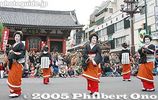
Edo Geisha portrayed by Asakusa geisha.江戸芸者Nov 09, 2005
|
|

Edo Geisha江戸芸者Nov 09, 2005
|
|

Edo Geisha江戸芸者Nov 09, 2005
|
|

Edo Geisha江戸芸者Nov 09, 2005
|
|

Edo Geisha江戸芸者Nov 09, 2005
|
|

Edo Geisha, She was the only one with a smile.Nov 09, 2005
|
|
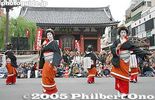
Edo Geisha江戸芸者Nov 09, 2005
|
|
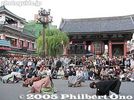
Mito Komon: He travels around incognito to help people being oppressed by corrupt officials, etc. When he reveals his real identity to the villains, they instantly go down on their knees and maybe even poop in their pants.Bowing to Mito Komon.
江戸の人気者Nov 09, 2005
|
|

Edo Geisha 江戸芸者江戸芸者Nov 09, 2005
|
|
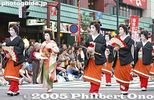
Edo Geisha. These geisha are from Asakusa, which also happens to be one of Tokyo's geisha districts. 江戸芸者Nov 09, 2005
|
|

Edo Geisha江戸芸者Nov 09, 2005
|
|
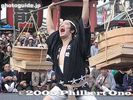
Edo's Popular People--Isshin Tasuke, a fish peddler and a very popular fictional character. 江戸の人気者(一新太助)Nov 09, 2005
|
|

Edo Geisha江戸芸者Nov 09, 2005
|
|
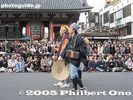
Edo's Popular People: Mito Komon, an important lord related to the Tokugawa Shogun. He was based in Mito, Ibaraki Pref. Most people know him through the popular Mito Komon TV series. Most people know him through the popular Mito Komon TV series where he is shown traveling around incognito to help people being oppressed by corrupt officials, etc. When he reveals his real identity to the villains, they instantly go down on their knees and maybe even poop in their pants.
江戸の人気者Nov 09, 2005
|
|

Ikyu, the villain. 花川戸助六 意休Nov 09, 2005
|
|
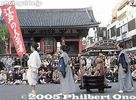
Edo's Popular People 江戸の人気者江戸の人気者Nov 09, 2005
|
|
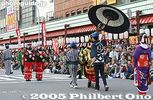
Oiran Dochu Procession花の吉原おいらん道中Nov 09, 2005
|
|

Hanakawa do Sukeroku, a favorite son of Asakusa and famed womanizer. He was loved by the people since he sided with the weak and defeated the strong. Made into a kabuki character. 花川戸助六 意休Nov 09, 2005
|
|
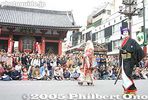
Hanakawa do Sukeroku & Ikyu (kabuki characters). Sukeroku and Ikyu vie for the love of a courtesan named Agemaki. 花川戸助六 意休Nov 09, 2005
|
|

Oiran Dochu Procession花の吉原おいらん道中Nov 09, 2005
|
|

Oiran Dochu Procession in front of Kaminarimon Gate, Asakusa.花の吉原おいらん道中Nov 09, 2005
|
|
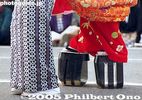
Oiran Dochu Procession. Her clogs. 花の吉原おいらん道中Nov 09, 2005
|
|
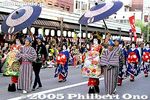
Oiran Dochu Procession. This picture was taken in the 1990s when they had two oiran in the festival. Now they have only one. 花の吉原おいらん道中Nov 09, 2005
|
|

Oiran Dochu Procession花の吉原おいらん道中Nov 09, 2005
|
|
|
|
|

Oiran Dochu Procession花の吉原おいらん道中Nov 09, 2005
|
|

She walks in a very slow and stylized way, her feet taking figure-8 steps. She needs the man's shoulder to steady herself.Nov 09, 2005
|
|

The oiran courtesan is escorted by two little girls called kamuro. 花の吉原おいらん道中Nov 09, 2005
|
|

Oiran Dochu Procession. The two little girls are called kamuro.Nov 09, 2005
|
|

Oiran Dochu ProcessionNov 09, 2005
|
|
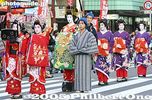
Oiran Dochu Procession. This is definitely the highlight of the festival, and my favorite part of the festival. 花の吉原おいらん道中Nov 09, 2005
|
|
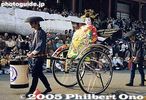
Oiran Dochu Procession. This picture was taken next to the Sensoji Temple behind which the parade starts. Before, one oiran courtesan rode in a rickshaw. 花の吉原おいらん道中花の吉原おいらん道中Nov 09, 2005
|
|

Saruwaka Sanza, Edo Kabuki猿若三座 江戸歌舞伎Nov 09, 2005
|
|
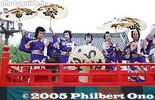
Saruwaka Sanza, Edo Kabuki. "Sanza" means three theaters. 猿若三座 江戸歌舞伎猿若三座 江戸歌舞伎Nov 09, 2005
|
|
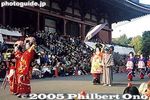
Oiran Dochu Procession 花の吉原おいらん道中Nov 09, 2005
|
|
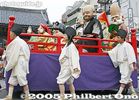
Seven Gods of Good Fortune 浅草市村座七福神舞浅草市村座七福神舞Nov 09, 2005
|
|

Firemen's Acrobatics大岡越前守と江戸町火消Nov 09, 2005
|
|
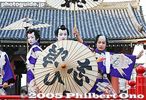
1624: Saruwaka Sanza, Edo Kabuki. Kabuki was started in the early Edo Period in 1624. Later, Edo's three licensed kabuki theaters named the Nakamura-za, Ichimura-za, and Morita-za were relocated to Asakusa in an area called Saruwaka."Sanza" means three theaters. 猿若三座 江戸歌舞伎Nov 09, 2005
|
|

1717: Firemen's Acrobatics. Ooka Echizen no Kami Tadasuke (1677-1751) and Edo Fire Brigade. Ooka was a famous Edo magistrate who organized fire brigades in Edo. 大岡越前守と江戸町火消Nov 09, 2005
|
|

Firemen's Acrobatics大岡越前守と江戸町火消Nov 09, 2005
|
|

This story of loyalty soon becomes a timeless classic known as "Chushingura." 義士の討ち入りNov 09, 2005
|
|

Firemen's Acrobatics 大岡越前守と江戸町火消Nov 09, 2005
|
|
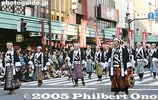
On Dec. 14, 1702, Asano's 47 masterless retainers avenged their master's death by attacking and beheading Kira at his residence in Ryogoku.義士の討ち入りNov 09, 2005
|
|

Genroku Flower-Viewing DanceNov 09, 2005
|
|

Genroku Flower-Viewing Dance 元禄花見踊りNov 09, 2005
|
|

Year 1702: The 47 masterless retainers arrive to avenge their lord. In 1701 in the shogun's palace, Lord Asano Naganori draws his sword in a fit of anger and cuts Kira Yoshinaka, the highest-ranking master of protocol who had mocked Asano.Asano was immediately forced to commit ritual seppuku. At the end of the following year, his 47 masterless retainers avenged their master's death by attacking and beheading Kira at his residence in Ryogoku. This story of loyalty soon becomes a timeless classic known as "Chushingura."
義士の討ち入りNov 09, 2005
|
|
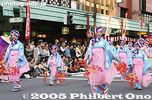
Genroku Flower-Viewing Dance. The Genroku Period was 1688-1704, a time of cultural flowering among the masses. 元禄花見踊りNov 09, 2005
|
|

Sankin Kotai Daimyo Gyoretsu参勤交代 大名行列Nov 09, 2005
|
|

Sankin Kotai Daimyo Gyoretsu参勤交代 大名行列Nov 09, 2005
|
|
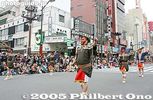
1635: Sankin Kotai Daimyo Gyoretsu. The daimyo was a warlord who owned and supervised a fief. Tokugawa Iemitsu started the Sankin kotai system where all daimyo were required to visit Edo annually at great expense. 参勤交代 大名行列The daimyo was a warlord who owned and supervised a fief. Tokugawa Iemitsu started the Sankin kotai system where all daimyo were required to visit Edo annually at great expense since they traveled in a large contingent.
参勤交代 大名行列Nov 09, 2005
|
|
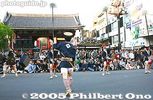
Sankin Kotai Daimyo Gyoretsu. "Gyoretsu" means procession. It was a great expense since they traveled in a large contingent. 参勤交代 大名行列Nov 09, 2005
|
|

Sankin Kotai Daimyo Gyoretsu in front of Kaminarimon Gate.参勤交代 大名行列Nov 09, 2005
|
|

Sankin Kotai Daimyo Gyoretsu palanquin. This is how the daimyo traveled--in a comfortable box hand-carried by men. 参勤交代 大名行列Nov 09, 2005
|
|
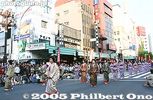
Inner palace women 大奥御殿女中Nov 09, 2005
|
|
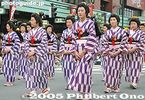
Inner palace womenNov 09, 2005
|
|
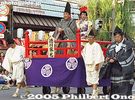
1649: Tokugawa Iemitsu. In 1649 during his reign as shogun, Asakusa Shrine was built. 徳川家光 三社権現社再建寄進Nov 09, 2005
|
|

Sankin Kotai Daimyo Gyoretsu 参勤交代 大名行列Nov 09, 2005
|
|

Lord Ii Naomasa, a right-hand man of Tokugawa Ieyasu and major ally in the Battle of Sekigahara in 1600. Based in Hikone, Shiga Prefecture. 井伊直政 徳川家康 江戸入府Nov 09, 2005
|
|

Year 1603: Tokugawa Ieyasu becomes Shogun. He designates Asakusa Temple as a place of worship, and he worships there himself in 1616. Behind him is his son Tokugawa Hidetada who became the second Tokugawa shogun. 徳川家康 江戸入府Nov 09, 2005
|
|

Inner palace womenNov 09, 2005
|
|

Inner palace women. 大奥御殿女中Nov 09, 2005
|
|
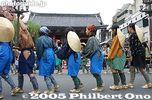
Edo Castle construction: Rock-hauling procession江戸城築城 お石曵きNov 09, 2005
|
|

Tokugawa Ieyasu takes up residence in Edo and founds the Tokugawa or Edo Period that lasted until 1868.徳川家康 江戸入府Nov 09, 2005
|
|
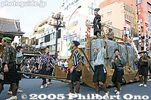
Edo Castle construction: Rock-hauling procession. Not a real boulder.Nov 09, 2005
|
|

Tokugawa Ieyasu takes up residence in Edo. 徳川家康 江戸入府Nov 09, 2005
|
|
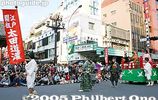
Year 1457: Ota Dokan, initial builder of Edo Castle. 江戸開祖 太田道灌、従者・山吹娘Nov 09, 2005
|
|

Year 1590: Tokugawa Ieyasu takes up residence in Edo. His procession. 徳川家康 江戸入府Nov 09, 2005
|
|
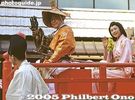
Ota Dokan, initial builder of Edo Castle. This is played by Shun'ichi Suzuki, the then governor of Tokyo. Body guards were around his float. He is dressed in a hunter's costume. Behind him is an attendant named Yamabuki.江戸開祖 太田道灌、従者・山吹娘Nov 09, 2005
|
|

Edo Castle construction: Rock-hauling procession. 江戸城築城 お石曵きNov 09, 2005
|
|

Sanja portable shrines on boats. Sanja means "Three Shrines." The three fishermen who found the Kannon buddha statue (the origin of Sensoji Temple) are deified by Asakusa Shrine next to Sensoji Temple. 三社大権現祭礼 船渡御This is the first portable shrine. The portable shrines used to be paraded in a boat.
三社大権現祭礼 船渡御Nov 09, 2005
|
|

1608: Ieyasu orders Edo Castle expansion: Rock-hauling procession. Big boulders were hauled from Izu Peninsula's east coast. 江戸城築城 お石曵きNov 09, 2005
|
|
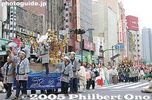
Asakusa Shrine holds the annual Sanja Matsuri in May, one of Tokyo's biggest festivals. Three portable shrines dedicated to these three fishermen are carried around the streets of Asakusa. "Sanja" means three shrines or gods. Portable shrineSecond and third portable shrines.
三社大権現祭礼 船渡御Nov 09, 2005
|
|
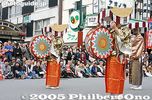
The Binzasara is a musical instrument made of 108 strips of white cedar wood strung together at the top. It is held on both ends and shaken in a wave motion to make a sharp wood clapping sound. It is also accompanied by drums as seen here.びんざさら舞
三社大権現祭礼 船渡御Nov 09, 2005
|
|
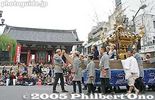
Third portable shrine. 三社大権現祭礼 船渡御Nov 09, 2005
|
|
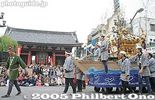
Second portable shrine. 三社大権現祭礼 船渡御Nov 09, 2005
|
|
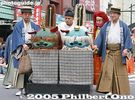
Binzasara Dance三社大権現祭礼 船渡御Nov 09, 2005
|
|

White Heron DanceNov 09, 2005
|
|

Shrine maiden and Kaminarimon Gate in Asakusa三社大権現祭礼 船渡御Nov 09, 2005
|
|

Binzasara Dance from Asakusa Shrine. They also throw confetti during the dance.This dance also originated in Asakusa by farmers who celebrated the completion of a tea house in Asakusa near the Asakusa Sensoji Temple. It is now a dance to celebrate a good harvest.
The Binzasara is a musical instrument made of small pieces of white cedar wood strung together at the top. It is held on both ends and shaken in a wave motion to make a sharp wood clapping sound.
びんざさら舞
三社大権現祭礼 船渡御Nov 09, 2005
|
|

White Heron Dance rear viewNov 09, 2005
|
|

Sarutahiko, Guardian of the earth. 猿田彦 三社大権現祭礼 船渡御Nov 09, 2005
|
|
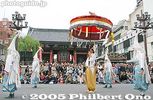
White Heron DanceNov 09, 2005
|
|
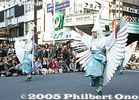
The scroll showed the White Heron Dance being performed for peace when the temple completed a major renovation. 白鷺の舞
It is one of the highlights of the festival. It is also performed on other occasions in Asakusa.
白鷺の舞
三社大権現祭礼 船渡御Nov 09, 2005
|
|
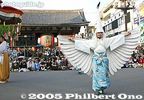
White Heron DanceNov 09, 2005
|
|
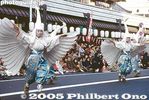
The White Heron Dance originated in Kyoto over 1,100 years ago to purge the city of an epidemic.Nov 09, 2005
|
|
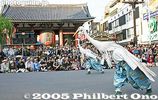
White Heron Dance in front of Kaminarimon Gate.Nov 09, 2005
|
|

White Heron Dance, Shirasagi no Mai. The eight white herons represent four male and four female herons.Nov 09, 2005
|
|

Hojo Masako worships at Asakusa Temple. 北条政子 浅草寺参拝Nov 09, 2005
|
|

White Heron Dance is one of the highlights of the festival. It is also performed on other occasions in Asakusa. The dance was revived in 1968 in Asakusa to mark the Meiji Period Centennial. It has been performed annually on Nov. 3 ever since. 白鷺の舞Nov 09, 2005
|
|

This White Heron Dance troupe consists of 3 warriors, 1 baton twirler, 1 feeder, 1 grand-umbrella holder, 8 white herons, 19 musicians and guardian children in traditional costumes of the Heian Period.Nov 09, 2005
|
|
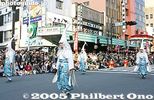
White Heron Dance, called Shirasagi no Mai, was revived in 1968 by the Asakusa tourist federation. Originating from the Heian Era, the dance was depicted in a picture scroll owned by the Sensoji Temple. 白鷺の舞It shows the dance being performed for peace when the temple completed a major renovation.
The dance troupe consists of 3 warriors, 1 baton twirler, 1 feeder, 1 grand-umbrella holder, 8 white herons, 19 musicians and guardian children in traditional costumes of the Heian Period.
It is one of the highlights of the festival. It is also performed on other occasions in Asakusa.
白鷺の舞
三社大権現祭礼 船渡御Nov 09, 2005
|
|
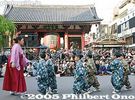
Tokyo Jidai Matsuri 三社大権現祭礼 船渡御Nov 09, 2005
|
|

Forces of Minamoto no Yoritomo (1147-1199), the founder and the 1st shogun of the Kamakura Period, who ruled from 1192 until 1199. He is said to have prayed at Asakusa Temple for victory over the Taira Clan to become shogun. 源頼朝 隅田川陣営源 頼朝 隅田川陣営Nov 09, 2005
|
|

Hojo Masako worships at Asakusa TempleNov 09, 2005
|
|

Hojo Masako (1156-1225), wife of Minamoto no Yoritomo, worships at Asakusa Temple. As the wife of the first shogun and mother of the second and third shoguns, she was a powerful lady. 北条政子 浅草寺参拝Nov 09, 2005
|
|
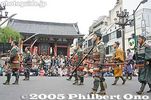
Minamoto no Yoritomo 源 頼朝 隅田川陣営Nov 09, 2005
|
|

Minamoto no Yoritomo (Hatakeyama Shigetada). His prayers for victory were answered. 源 頼朝 隅田川陣営 (畠山重忠)Nov 09, 2005
|
|
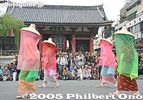
在原業平 東下りNov 09, 2005
|
|

在原業平 東下りNov 09, 2005
|
|

Ariwara no Narihira (825-880) comes to east Japan在原業平 東下りNov 09, 2005
|
|

Ariwara no Narihira (825-880) comes to east Japan. He was a Japanese waka poet and aristocrat. He was one of six waka poets referred in the preface in kana to Kokinshu by Ki no Tsurayuki. A woman portrays him. 在原業平 東下りNov 09, 2005
|
|
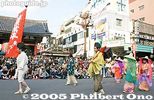
Ariwara no Narihira (825-880) comes to east Japan 在原業平 東下りNov 09, 2005
|
|
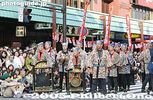
Golden Dragon Dance musiciansNov 09, 2005
|
|

Golden Dragon DanceNov 09, 2005
|
|
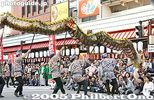
Golden Dragon DanceNov 09, 2005
|
|

Golden Dragon DanceNov 09, 2005
|
|
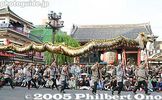
Golden Dragon Dance. No smoke or fire came out of the mouth. The dragon is 15 meters long, weighing about 80 kg. It has a bamboo frame, covered with cloth. Eight men use poles to manipulate the golden dragon.Nov 09, 2005
|
|
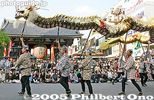
According to legend, three days after the golden Kannon statue was found, a golden dragon descended from heaven and danced. The mountain name of the temple is Kinryu-zan, meaning Golden Dragon Mountain. (Most temples have a mountain name.)Nov 09, 2005
|
|
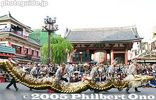
Golden Dragon Dance was first performed in 1958 to commemorate the reconstruction of Sensoji's main worship hall. 浅草のよろこび 金龍の舞Nov 09, 2005
|
|

Nov 09, 2005
|
|

Year 628: Two fishermen brothers find a golden Kannon buddha statue in Sumida River. The two fishermen were Hinokuma no Hamanari and Takenari. A wealthy landowner named Hajinomatsuchi heard about the statue and told the brothers about its religious value.He then built a small temple for the statue and the brothers converted to Buddhism. The temple eventually became today's Sensoji Temple (also called Asakusa Kannon Temple). Because of the temple, Asakusa developed and prospered and the two brothers and landlord are considered to be the founders of Asakusa.
Next to Sensoji Temple is Asakusa Shrine dedicated to these three men now deified. Asakusa Shrine holds the annual Sanja Matsuri in May, one of Tokyo's biggest festivals. Three portable shrines dedicated to these three men are carried around the streets of Asakusa. "Sanja" means three shrines or gods.
檜前浜成(ひのくまのはまなり)・竹成(たけなり)の兄弟の網に一体の小さなご仏像がかかりました。
東京のあけぼの 浅草観音示現Nov 09, 2005
|
|
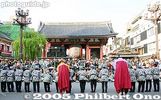
Golden Dragon Dance. 浅草のよろこび 金龍の舞Nov 09, 2005
|
|
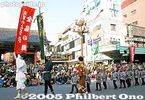
Nov 09, 2005
|
|
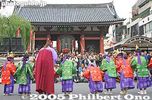
Magistrate Procession. Bowing to Asakusa Temple.Nov 09, 2005
|
|

Magistrate Procession 奉行Nov 09, 2005
|
|
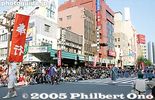
Magistrate Procession 奉行Nov 09, 2005
|
|
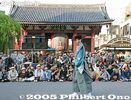
A magistrate (bugyo) in Edo could be a regional governor or government minister.Nov 09, 2005
|
|

Tekomai geishaNov 09, 2005
|
|

Tekomai geisha costume is partially masculine with trousers instead of skirts. Their right shoulder is "exposed" showing a flower design. They carry a red paper lantern imprinted with their names and use their right hand to drag a wand."Asakusa" is written on her lantern. 手古舞Nov 09, 2005
|
|
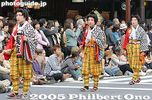
Tekomai geisha existed since the Edo Period. They served as side entertainment at festivals. They only sing traditional chant-like songs called kiyari originally sung by lumberers hauling wood. 手古舞These tekomai did not sing, so they might not be real. When they sing, they hold a fan to their mouth.
手古舞Nov 09, 2005
|
|
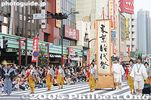
Tokyo Jidai Matsuri Banner and Tekomai geisha. From top to bottom, the banner reads, "Tokyo Jidai Matsuri." It marks the official and real start of the festival parade. The first Tokyo Jidai Matsuri was held in 1989. 東京時代祭本旗The first Tokyo Jidai Matsuri was held in 1989. Slight changes in the festival have been made since. Instead of two oiran courtesans, there is only one now. And at the end of the parade, the Asakusa Revue of showgirls used to be the anchor. But they are now gone.
東京時代祭本旗、手古舞Nov 09, 2005
|
|

Lead float with Edo festival music played by children. The names of the children playing are written on the red lanterns hanging above. Kodomo Edo-bayashi yatai 先導 子供江戸囃子屋台Nov 09, 2005
|
|

From Matsuya Department Store, the procession turns right into Kaminarimon-dori street which passes in front of the famous, giant red lantern called Kaminarimon Gate. Lead float with Edo festival music played by children. 先導 子供江戸囃子屋台Nov 09, 2005
|
|
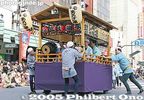
Sadly, the Tokyo Jidai Matsuri no longer held. It used to be held annually on Nov. 3 (Culture Day) in Asakusa, Tokyo.the Tokyo Jidai Matsuri (Festival of Historical Periods) is a parade tracing the history of Tokyo with over 1,600 people dressed in the respective period's costume. This is the lead float playing music. It took about an hour for the parade to reach Kaminarimon Gate.
Lead Float: Edo festival music played by children. Kodomo Edo-bayashi yatai
先導 子供江戸囃子屋台
Nov 09, 2005
|
|
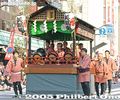
This page is a complete English guide to all the groups that appear in the parade. The parade assembles behind Sensoji Temple and starts at 1:30 pm from Nitenmon gate. The procession then goes down Umamichi-dori street, passes by Matsuya Department Store.先導 子供江戸囃子屋台Nov 09, 2005
|
|

"Quadrifogli " (Clovers of Light) at Tokyo StationNov 06, 2005
|
|

Nov 06, 2005
|
|

Nov 06, 2005
|
|

Tokyo StationNov 06, 2005
|
|

"No stopping please..."Nov 06, 2005
|
|

Nov 06, 2005
|
|

Back of entranceNov 06, 2005
|
|

Less crowded at the end. After you pass through the main street, there are more decorations on the side street. You can also backtrack on the main street along the sidewalk only.So if you want to see the Millenario really quickly and don't mind not being in the middle of the street, go on the sidewalk.Nov 06, 2005
|
|

5:40 pm: Entered Tokyo Millenario streetNov 06, 2005
|
|

Nov 06, 2005
|
|

Nov 06, 2005
|
|

Nov 06, 2005
|
|

5:34 pm: Entrance in sightNov 06, 2005
|
|

Nov 06, 2005
|
|

Title of work: "Corolle Liberty" by Valerio FestiThe artist is Italian.Nov 06, 2005
|
|
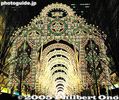
Entrance. The entrance gate is 22 meters tall and 19 meters wide.Nov 06, 2005
|
|

Tokyo Millenario was a brilliant sculpture of light mounted over a street in Marunouchi near Tokyo Station. From 1999 to 2005, it was held during the last week of the year until New Year's Day. The event was discontinued after 2005 due to constructioTokyo Millenario was mounted over a small street in Marunouchi called Marunouchi Naka-dori during the last week of the year. It lit up from 5:30 pm to 9 pm and on Jan. 1 (the last day), from midnight to 3 am. It became a major winter attraction, with over 2 million visitors in 2004.
The crowds were horrendous. It took 40 min. or longer just to get in. Photo: 5:05 pm: At the back of the line.Nov 06, 2005
|
|

Behind usNov 06, 2005
|
|

"Red light ahead, please stop..."Nov 06, 2005
|
|

5:16 pm: Our line merges with another one coming from Tokyo StationNov 06, 2005
|
|

Imperial Palace Nijubashi Bridge. It is one of Tokyo's symbols. Behind the bridge, you can see Fushimi Turret. This picture was taken on a different day and not while we were crossing the bridge.Nov 06, 2005
|
|

10:25 am: Clearing out the crowd. We were promptly herded to the exit to make room for the next horde of people waiting to see the Emperor who appeared two more times that day.Nov 06, 2005
|
|
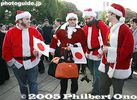
Even Santa Claus came (from Finland??). I'm told that they might be Finns. (Santa is from Finland.)Nov 06, 2005
|
|
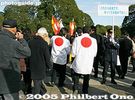
Japan fans. The sign says, "Downward slope ahead, walk slowly." It's only about 10:30 am, so it's a good time to walk around the Imperial Palace and the East Gardens. Although no flowers are in bloom, you might see autumn leaves.For more info about the Imperial Family and visiting the palace, see the Imperial Household Agency's Web site.Nov 06, 2005
|
|
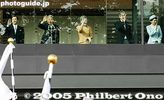
10:23 am: They wave to the crowd again. From left to right is the Crown Prince, the Emperor, the Empress, and Prince and Princess Akishino.It was very difficult to get a good shot of them since so many flags were in the way. I had to hold the camera overhead above the flags and shoot almost blindly with my telephoto lens. Luckily, I managed to get a few decent closeup shots.Nov 06, 2005
|
|

10:22 am: The Emperor speaks. When the Emperor spoke, the crowd immediately fell silent and all the flags stopped waving. He spoke for only about a minute, thanking us for celebrating his birthday and mentioning this past year's numerous natural disasAfter he finished, everyone waved the flags again and cheered.Nov 06, 2005
|
|
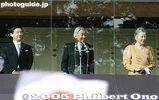
The Crown Prince, the Emperor, and the Empress on the Emperor's Birthday. They were on the balcony for a whole THREE minutes. I thought they would stay there for at least 10 min. Barely had time to mount my telephoto lens.Nov 06, 2005
|
|
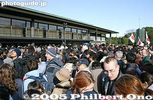
Filled on our rightNov 06, 2005
|
|

Behind us. At the very rear below the trees, there is a slightly elevated platform where the news media can take photos. You can see many tripods set up. That's how they are able to photograph the Emperor with the flags waving well below the balcony.Nov 06, 2005
|
|

9:57 am: Filled on our left. The entire place was full by 10 am. Quite a few foreigners were present as well. Rightists with large flags were also there.Nov 06, 2005
|
|

10:24 am: After 3 min. on the balcony, they were gone. We waited almost 2 hours for a 3-min. appearance. But I think it's something you should do at least once while in Japan.Nov 06, 2005
|
|
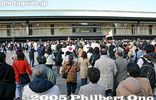
Good locationNov 06, 2005
|
|

Nov 06, 2005
|
|

9:43 am: Almost front and centerNov 06, 2005
|
|
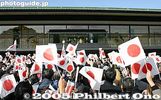
10:20 am: The Emperor and Empress appear right on time on his birthday. As soon as they appeared, people waved paper flags and cheered "banzai!" Also see the video at YouTube.It was an amazing spectacle. I always saw it on TV, but this was the first time I saw it in person. I wish I went when Emperor Hirohito was still living.
From left to right is Princess Nori, the Crown Prince, the Emperor, the Empress, and Prince and Princess Akishino. Crown Princess Masako did not appear due to illness.
I also once used this shot for the cover photo on my home page.Nov 06, 2005
|
|
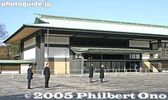
Entrance for state guests. This is where heads of state and other royalty enter this building.Nov 06, 2005
|
|

Kyuden Totei plazaNov 06, 2005
|
|

Filling up the plazaNov 06, 2005
|
|

People behind fill up the rest of the plazaNov 06, 2005
|
|

9:38 am: Crossing the second bridge. The first Nijubashi Bridge, which we crossed first, is in the distance. Nijubashi means double bridge. 二重橋Nov 06, 2005
|
|
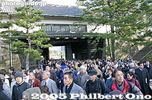
Out of the main gate. Everything was very orderly, no pushing nor shoving.Nov 06, 2005
|
|

The center is filled up first. The center is in front of the balcony where the Imperial family will appear. Thus, the earlier you go, the better chance of you standing in front of the balcony.Nov 06, 2005
|
|
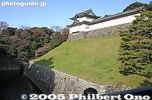
Fushimi Turret. This view of the turret can only be had when you cross the bridge. I never knew what it really looked like until this day. 伏見櫓Nov 06, 2005
|
|
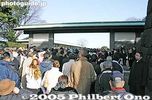
Nakamon Gate to Imperial Palace 中門Nov 06, 2005
|
|

9:40 am: Inside the Imperial Palace. This is called the Kyudentotei. It is a large plaza in front of the palace.Nov 06, 2005
|
|

Walking toward the second bridgeNov 06, 2005
|
|

9:35 am: Walking toward the second bridge. We walked up a slight slope to reach the second, parallel bridge. The Fushimi Turret is in the background.Nov 06, 2005
|
|

Fushimi Turret. This view of the turret can only be had when you cross the bridge. I never knew what it really looked like until this day. 伏見櫓Nov 06, 2005
|
|
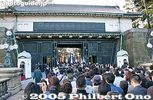
On Nijubashi Bridge heading for the Seimon Gate. 正門Nov 06, 2005
|
|

Main gateNov 06, 2005
|
|

Left view from Nijubashi Bridge. Everyone knows what the Nijubashi Bridge looks like from outside. Finally, we see what it looks like from the bridge. 二重橋Nov 06, 2005
|
|
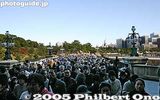
9:33 am: Behind us on Nijubashi Bridge. 二重橋Nov 06, 2005
|
|
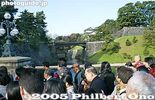
Right view from Nijubashi Bridge. In the distance, you can see another parallel bridge which leads directly into the inner grounds of the palace. We will cross that bridge too. There is also the castle-like structure called the Fushimi Turret.Nov 06, 2005
|
|

9:31 am: Crossing the famous Nijubashi Bridge. It turned out to be a completely modern bridge, no sqeaking or anything. 二重橋Nov 06, 2005
|
|

Nijubashi Bridge straight ahead!Nov 06, 2005
|
|

Getting closer to the bridgeNov 06, 2005
|
|
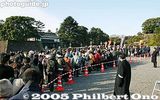
9:28 am: Finally walking toward Nijubashi Bridge. There were a lot of men in trench coats gazing at the crowd.Nov 06, 2005
|
|

9:20 am: Long line behind. If it's a sunny day, it's sunburn time. We waited here for over 30 min.Nov 06, 2005
|
|

Approaching the entrance near Nijubashi BridgeNov 06, 2005
|
|

Merging with another line up aheadNov 06, 2005
|
|
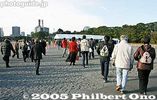
Body inspection up ahead. They frisked the body and also used a metal detector as well. I had to explain that the hump in my pants pocket was a wallet and cell phone. He believed me since I have an honest-looking face.Nov 06, 2005
|
|

Lining up in line 1Nov 06, 2005
|
|
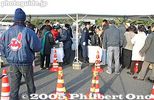
8:40 am: Bag checkNov 06, 2005
|
|

8:43 am: Passed body check and walking to waiting line. After seeing these coned lanes, I was glad that I went early. I don't know if all these lanes were later filled with people, but probably yes.Nov 06, 2005
|
|
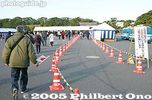
Bag checkpoint ahead. They inspected all our bags. Note that they do not allow any drinks (not even water) to be taken into the palace. You will have to dump it in the trash can they provide.Nov 06, 2005
|
|

Dec. 23, 2004 at 8:30 am: Across the street from the Imperial Palace. Dec. 23 and Jan. 2 are the only two days when the general public is allowed to enter the palace to greet the Emperor and his family.A visit to the Imperial Palace by the general public is called "ippan sanga" in Japanese (一般参賀).
On the Emperor's birthday, the Imperial Palace can be entered only at certain locations. You have to find out where they are and stand in line there. Just go near the Imperial Palace and ask a policeman where you can stand in line. You otherwise cannot enter the grounds. The huge, graveled plaza where you can see Nijubashi Bridge is closed off by police.
While standing in line here, we received free paper Japanese flags. Nov 06, 2005
|
|
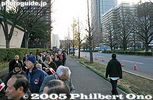
Line behindNov 06, 2005
|
|

8:37 am: We crossed the street to enter Imperial Palace groundsNov 06, 2005
|
|

Honda MotorcyclesAt the end of the day, the companions line up in front of their booth to say goodbye. Great photo op too.Nov 05, 2005
|
|
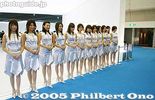
Yamaha MotorcyclesAt the end of the day, the companions line up in front of their booth to say goodbye. Great photo op too.Nov 05, 2005
|
|
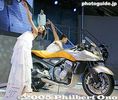
Suzuki Stratosphere motorcycleSuzuki put on a great show with a bunch of girls doing hip-hop dancing.Nov 05, 2005
|
|

Suzuki MotorcyclesSuzuki put on a great show with a bunch of girls doing hip-hop dancing.Nov 05, 2005
|
|

Yamaha MotorcyclesYamaha's booth was the most elegant in the motorcycle section.Nov 05, 2005
|
|

Honda E4-01 motorcycleNov 05, 2005
|
|

Suzuki MotorcyclesNov 05, 2005
|
|
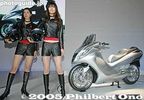
Honda E4-01 motorcycleNov 05, 2005
|
|

Honda MotorcyclesNov 05, 2005
|
|

Kawasaki ZZR 1400 ABS motorcycleI looked at her and she smiled.Nov 05, 2005
|
|
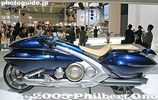
Yamaha Gen-Ryu motorcycleNov 05, 2005
|
|

Kawasaki MotorcyclesOne of the best-looking motorcycle models.Nov 05, 2005
|
|
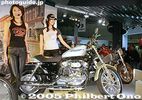
Harley-Davidson. In 1999, the show combined passenger cars and motorcycles. Also, in 1999, the show for commercial vehicles was omitted and instead to be held in a separate show in alternating years starting in 2000.Nov 05, 2005
|
|

Harley-Davidson FXDI 35th Anniversary Super GlideWorld premiere of this bike.Nov 05, 2005
|
|

Kawasaki MotorcyclesI wasn't one of them.Nov 05, 2005
|
|
| 17881 files on 71 page(s) |
 |
 |
 |
 |
70 |
|